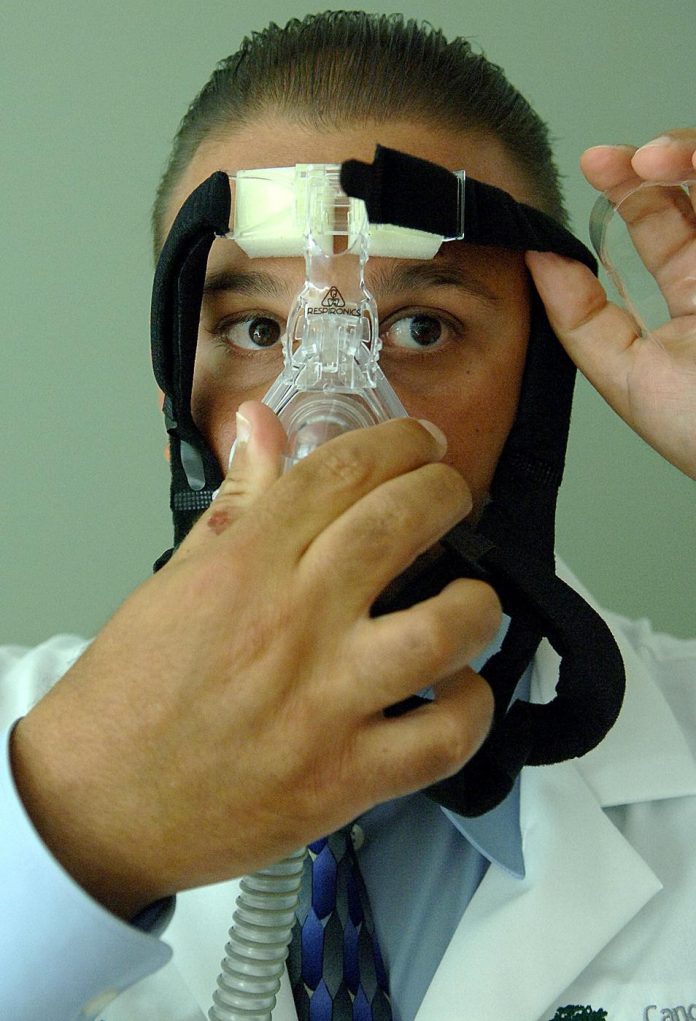Dr. David Visco holds the mask, which is connected to the C-PAP machine, up to his face. The machine blows air into the patient’s nose so that he or she can breathe easier during sleep. JENNY SWIGODA / TIMES PHOTO
Dr. David Visco has unmasked a new way to treat sleeping disorders.
Cancer. It’s a word with so much meaning.
The patients who hear they have it know, or come to know, it means their lives will never be the same. There will be new medicines, new therapies, doctor visits, hospital stays and pain.
And one more thing — fatigue.
The diagnosis of cancer can cause anxiety, fear, grief and depression, all of which can make sleeping difficult.
Ninety percent of the patients experience “cancer-related fatigue,” said internist Dr. David Visco, adding that patients’ underlying sleep disorders contribute to that problem.
According to the National Cancer Institute, 25 percent of the population experiences serious sleep problems, but that number surges to 45 percent for cancer patients.
Dealing with a sleeping problem might not seem that urgent to a patient who has been diagnosed with cancer, Visco said.
“Everything else takes a back seat [to cancer treatment],” said Visco, who is the medical director at the Sleep Center at Cancer Treatment Centers of America on Wyoming Avenue.
But that problem of getting enough rest is severe, and some cancer medications and treatments make it even tougher to get to sleep, so the patients always feel tired. So much so that fatigue can become one of the most life-changing parts of cancer.
“Patients self-report that fatigue impacted their lives more than pain,” the doctor said.
Patients need their rest to recover their strength to help them battle cancer, and Visco said unrecognized sleeping disorders also present dangers to patients undergoing anesthesia for surgeries.
And it’s not just the patients who are affected, he added.
A cancer patient might sleep in the same bed with his or her main caregiver, whose sleep also is affected by the patient’s disorder.
Visco said nailing down exactly why a patient is not getting proper rest is the first step to correcting the condition.
For the doctor to make his diagnosis, the patient has to sleep at least four hours hooked up to monitoring screens in the next room. Most patients insist they will not fall asleep at all with wires attached from their heads to their chests, Visco said, but they do.
Technicians like Carole Turchi from Mayfair, monitor each patient’s airflow, muscle tone, snoring, heart rate, arm and leg movement, oxygen levels in the blood and teeth grinding.
What doctor and therapists are looking for is anything abnormal, but to do that they want their patients’ routines to be as normal as possible, Visco said.
“We want them to simulate exactly what they do at home,” the doctor said.
If a patient’s oxygen levels drop, he is not breathing well or not breathing at all, and his brain awakens him, Visco said, so the patient will breathe more regularly and get his oxygen levels up.
“Several disorders can lead to a patient’s restlessness at night and to fatigue, Visco said. Since he has been working at Cancer Treatment Centers of America, he’s done more than 100 sleep studies of cancer patients — about four a week — and he has found sleep disorders in all but 5 percent of them.
In February, colon cancer patient Christinea Fenstermacher was diagnosed as having sleep apnea, she said in a telephone interview.
“I was snoring, waking up and keeping my husband awake,” she said, “and I had no energy.”
The North Carolina resident said her sleep study showed airways were closing as she slept and she would then wake up.
“I thought I woke up four times,” she said, “but they told me I woke up more than 150 times.”
And that was in just four hours, she said.
Visco said he prescribed use of a small machine that gently forces air into the patient’s air passages. The machine, called a C-PAP (continuous positive airway pressure), increases the air pressure as the patient falls more soundly asleep.
By using the C-PAP, Fenstermacher is not only getting her rest, some of her other conditions have improved.
“I no longer take high-blood pressure medicine,” she said, adding that her depression is gone, so she no longer takes anti-depression medication.
Diagnosing a sleep disorder also helps anesthesiologists prepare for dealing with breathing irregularities that might be spotted during an operation and cause enough concerns that the surgery is stopped.
The C-PAP machine is used to treat many patients, but the doctor and his team employ other therapies, too, he said.
A C-PAP machine is not even a cubic foot, so it’s small enough to sit on a night table, and it weighs less than 5 pounds. The machine, which costs from $300 to $500, forces air through a patient’s airways so the patient gets the oxygen he needs.
“It’s just the air from the room,” Visco said, but he added that oxygen also can be delivered by C-PAP, too.
Fenstermacher said her C-PAP delivers oxygen.
Using the machine requires patients to wear a small mask that holds a tube that brings the air. A small number of patients — perhaps 5 percent, Visco said — don’t like the machine or its mask and refuse to use it. Other patients need encouragement and follow-up visits with the doctor before they use the C-PAP, the doctor said.
Most patients love the machine because they’re getting to sleep and staying asleep. They take it with them even when they’re traveling, Visco said.
“Once they’re used to it, they never leave it home,” he said. ••
For more on Dr. David Visco and the cancer center at 1331 E. Wyoming Ave., visit www.cancercenter.com
For more on sleep disorders and tips for sleeping well, visit www.cancercenter.com/after-care-services/sleep-problems.cfm
Reporter John Loftus can be reached at 215–354–3110 or [email protected]





